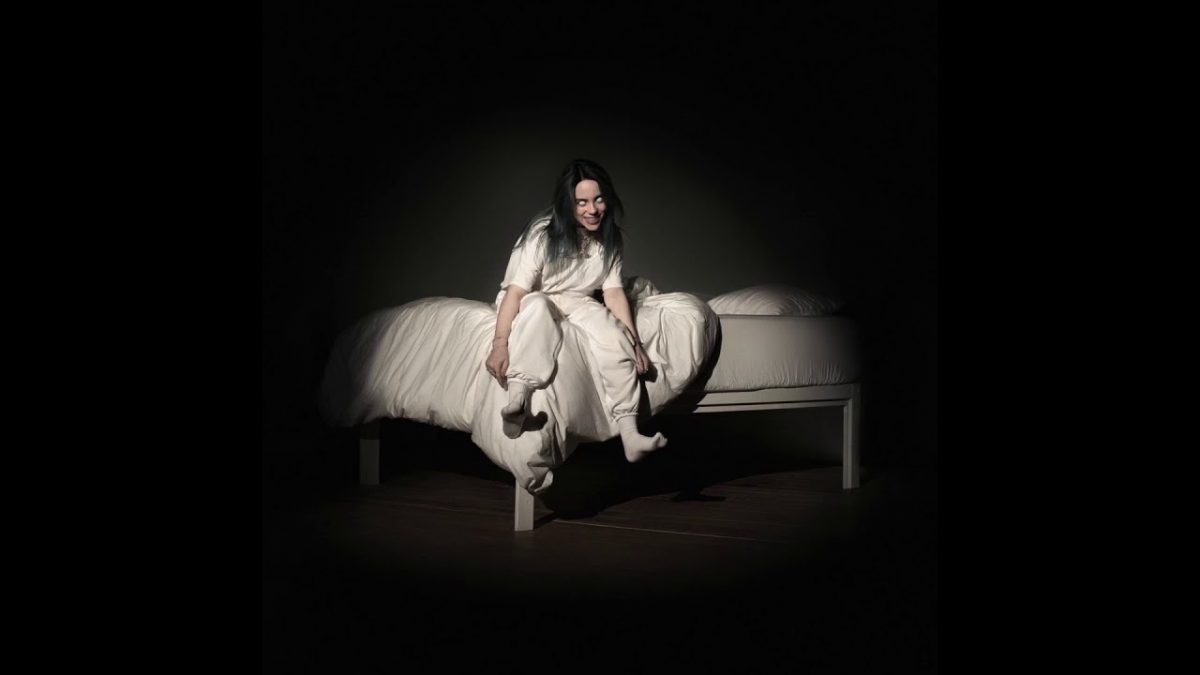
The aesthetic of Billie Eilish is glittering darkness. She mixes lyrics about hopelessness with bright synthesizers and radio-friendly hooks. Her rumination on the macabre has led some critics to declare that she is part of the second iteration of the goth subculture first popularized in the 1980s, but the label doesn’t quite fit. Surprisingly, she shares more in common with the emerging batch of young Soundcloud rappers like Lil Uzi Vert and Lil Pump. Eilish herself started on Soundcloud, and her music encompasses the trademarks of the “Soundcloud rap” genre: short, streamable music written and produced by a young artist. Her songs barely average three minutes long, and they are filled with enigmatic audio samples.
The first track on her debut album is an eight-second long clip of Eilish slurping spit, after which she declares, “I have taken out my Invisalign, and this is the album.” She moves freely between the booming, throaty vocals that she displays on “bad guy” and a babyish, almost whiny vocal persona. Her music consciously avoids characterization, combining moody acoustic guitar from the singer-songwriter genre and throbbing, club-like bass so strong that even her voice starts to reverberate.
Eilish is emphatic that her style is supposed to be “genre-less.” Her refusal of categorization — even as critics continue to call her the new face of pop — is what feels the most modern about her music. Lil Nas X, the twenty-year-old phenomenon behind “Old Town Road” and Eilish’s primary competitor for number one single this summer, has also made headlines for refusing categorization by straddling the line between country and rap. Lizzo’s celebratory rap tracks with extended flute solos and soul-influenced vocals are also part of the recent pushback against genre lines. In the landscape of modern music, it is becoming increasingly detrimental to stay in one lane. It has long been traditional for musicians to collaborate outside their genre for remixes, but the emerging music market demands that there be variety within the personal sound of an artist. And Eilish does just that. Recently, she even released a slew of new merchandise that features her name styled in the sharp, flame-like font that has long been used to denote death metal bands.

In artist Fahren Feingold’s painting, “Ocean Eyes” created for The Untitled Magazine’s Art issue, Eilish looks out from behind a green printed cloth that obscures the lower half of her face. Like her ill-fitting clothing, the scarf is a powerful metaphor for Eilish’s insistence on a division between the public and the private space. Even with 40 million followers on Instagram, Eilish still dabbles in secrets. In the painting, only her eyes are visible, their green/blue limpidity maintaining startling eye contact with the viewer. Even softened by the aqueous pinks and yellows of watercolor, her stare is still intimidating. The bandana that covers her nose and mouth is colored in ominous shades of green and black, the pattern on it revealing abstract, monstrous forms. You can almost make out an alien face, or the reptilian outline of twin creatures. These nightmarish images would be familiar to Eilish, who has spoken about how her debut album, WHEN WE ALL FALL ASLEEP, WHERE DO WE GO? is inspired by a landscape of night terrors. She has spoken frankly about her issues with sleep, claiming that she only has lucid dreams and derives inspiration from manipulating her nightmare-scape. The visuals accompanying her music portray horror movie tropes: bat wings, tar-black tears, slithering demons. In the music video for “you should see me in a crown,” she places a crown crawling with spiders on her head and lets one wriggle around her mouth
Eilish’s insistence upon privacy and her dark, sweatshirt-clad persona is a refreshing rebellion against the rise of the Photoshop-dependent Instagram influencer. Her freshness lies in her ability to seem uncalculated. Eilish’s persona is unrehearsed oddity: she even forgot the words to her song at Coachella.
When she performs live, she doesn’t so much dance as she does bop energetically around the stage, singing lyrics about existential, rather than personal, dread. The female pop phenomenons before her — Taylor Swift, Beyonce, Katy Perry — became famous for singing about breakups and makeups, turning romantic strife into power ballads with which fans could sing along. Billie Eilish’s songs, with their whispered melodies and their strange chord progressions, do not make for easy sing-alongs, nor do their lyrics deal with abundantly relatable feelings.
Instead, Eilish is vulnerable in a different kind of way: she deals in rawness, refusing the photoshopped glamour of the Instagram elite. In the Kardashian generation, Eilish’s dark, ill-fitting creative slant functions as a salve.



